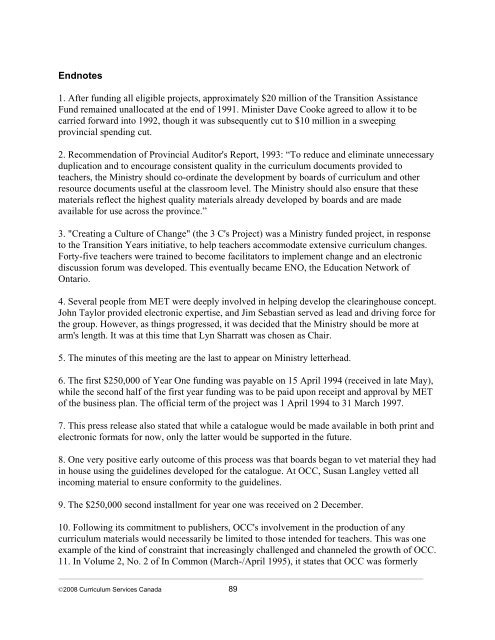a history of curriculum services canada
a history of curriculum services canada
a history of curriculum services canada
You also want an ePaper? Increase the reach of your titles
YUMPU automatically turns print PDFs into web optimized ePapers that Google loves.
Endnotes<br />
1. After funding all eligible projects, approximately $20 million <strong>of</strong> the Transition Assistance<br />
Fund remained unallocated at the end <strong>of</strong> 1991. Minister Dave Cooke agreed to allow it to be<br />
carried forward into 1992, though it was subsequently cut to $10 million in a sweeping<br />
provincial spending cut.<br />
2. Recommendation <strong>of</strong> Provincial Auditor's Report, 1993: “To reduce and eliminate unnecessary<br />
duplication and to encourage consistent quality in the <strong>curriculum</strong> documents provided to<br />
teachers, the Ministry should co-ordinate the development by boards <strong>of</strong> <strong>curriculum</strong> and other<br />
resource documents useful at the classroom level. The Ministry should also ensure that these<br />
materials reflect the highest quality materials already developed by boards and are made<br />
available for use across the province.”<br />
3. "Creating a Culture <strong>of</strong> Change" (the 3 C's Project) was a Ministry funded project, in response<br />
to the Transition Years initiative, to help teachers accommodate extensive <strong>curriculum</strong> changes.<br />
Forty-five teachers were trained to become facilitators to implement change and an electronic<br />
discussion forum was developed. This eventually became ENO, the Education Network <strong>of</strong><br />
Ontario.<br />
4. Several people from MET were deeply involved in helping develop the clearinghouse concept.<br />
John Taylor provided electronic expertise, and Jim Sebastian served as lead and driving force for<br />
the group. However, as things progressed, it was decided that the Ministry should be more at<br />
arm's length. It was at this time that Lyn Sharratt was chosen as Chair.<br />
5. The minutes <strong>of</strong> this meeting are the last to appear on Ministry letterhead.<br />
6. The first $250,000 <strong>of</strong> Year One funding was payable on 15 April 1994 (received in late May),<br />
while the second half <strong>of</strong> the first year funding was to be paid upon receipt and approval by MET<br />
<strong>of</strong> the business plan. The <strong>of</strong>ficial term <strong>of</strong> the project was 1 April 1994 to 31 March 1997.<br />
7. This press release also stated that while a catalogue would be made available in both print and<br />
electronic formats for now, only the latter would be supported in the future.<br />
8. One very positive early outcome <strong>of</strong> this process was that boards began to vet material they had<br />
in house using the guidelines developed for the catalogue. At OCC, Susan Langley vetted all<br />
incoming material to ensure conformity to the guidelines.<br />
9. The $250,000 second installment for year one was received on 2 December.<br />
10. Following its commitment to publishers, OCC's involvement in the production <strong>of</strong> any<br />
<strong>curriculum</strong> materials would necessarily be limited to those intended for teachers. This was one<br />
example <strong>of</strong> the kind <strong>of</strong> constraint that increasingly challenged and channeled the growth <strong>of</strong> OCC.<br />
11. In Volume 2, No. 2 <strong>of</strong> In Common (March-/April 1995), it states that OCC was formerly<br />
©2008 Curriculum Services Canada 89
















